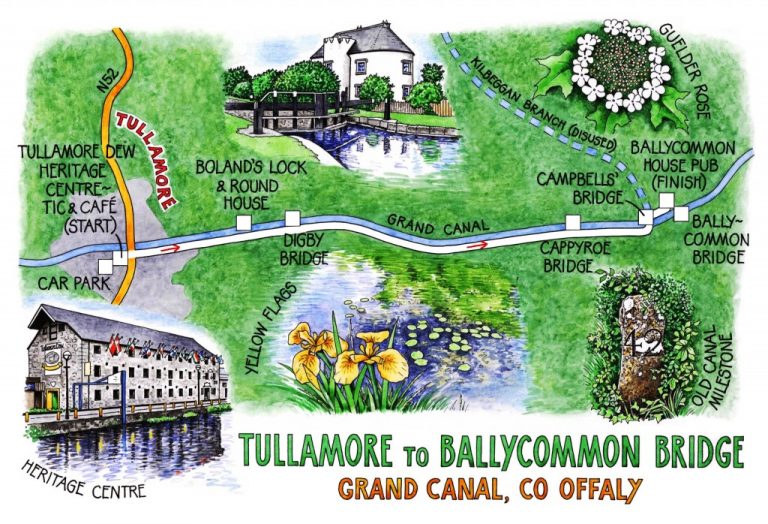Irish Independent – WALK OF THE WEEK – Christopher Somerville
31 July 2010
68. Tullamore to Ballycommon Bridge, Grand Canal, Co. Offaly

‘You’ll have a brilliant time along the Grand Canal today,’ offered Rose Mooney in the Tourist Office at Tullamore Dew Heritage Centre. ‘A bit of sun, nice dry path and some beautiful country, especially if you head out for Ballycommon. Hungry? Just down those steps in the café – you won’t do better anywhere!’
How right Rose was. Delicious, crispy, oven-baked focaccia: now that’s something you’d have struggled to find in deepest Offaly not so long ago. Jane and I stepped out replete into a gorgeous sunny afternoon under gently whispering poplars, just the kind of thing that makes you long to head for the hayfield with a jar of cider.
It was another drop of the good stuff that brought fame to Tullamore once the Grand Canal had reached the town at the end of the 18th century. Tullamore Dew became one of the world’s best-selling whiskeys, a rich and fiery concoction. It’s made at Midleton, Co Cork these days; the handsome old bonded warehouse in Tullamore now houses the Heritage Centre, and the canal still passes the door.
What a truly grand conception was the Grand Canal – a mighty thread for commerce and communication clean across the waist of Ireland for the best part of a hundred miles from Dublin to the Shannon, Irish Sea to Atlantic Ocean. It throve for half a century until the railways pinched most of its business. Nowadays the old waterway is alive with fish, frogs, birds, butterflies, wild flowers and dragonflies. You can sail it or bike it or walk it. The Offaly boglands are flat, and flat is beautiful in this context.
Water lily pads floated on the wind-ruffled water. Yellow flags raised their large papery flowers from clumps of rush and sedge. The canal arrowed away under its hump-backed bridges. A timeless, pastoral scene, rudely invaded by two flashing and beeping fire engines and half a dozen gallant gentlemen of the Fire Brigade. ‘There was a horse got himself stuck over a gate,’ disclosed a firefighter, with all the pride of one who has saved a princess from a blazing citadel, ‘but we got him off it, no trouble to him.’ The piebald horse himself lay in the recovery position a little further down the bank, rather pink around the gills, his eyes closed, waiting for all the nasty stuff to go far away.
At Boland’s Lock the Round House jutted towards the canal, a lock-keeper’s house rather grander than any other with its castellated gable and elliptical shape. The contractor who built it, Michael Hayes, just went ahead and created something that pleased him, but the board of directors of the Grand Canal weren’t that grand. Unimpressed by Hayes’s extravagance, they refused to pay his extra bill for the fancy bits – all £42.7.11d of it.
Pushing the canal through the soft, sucking peat bogs of the Midlands was a huge undertaking. It too five years just to cross the Bog of Allen. Coals, clothes, wood, crockery, wool, groceries, spare parts, beer, whiskey, people – the canal carried them all across Ireland. Now this former traffic artery sees the occasional boat, a scatter of anglers, some strollers such as ourselves, and one or two runners pink to the cheeks with exertion.
Electric blue damselflies hovered over the lily pads. Though the clear water we saw lazily waving weeds shaped like lettuces, like ash tree fronds, like strawberry flowers. There were genuine wild strawberries to pick and savour among the early purple orchids and yellow-headed black medick. Common twayblade grew in patches, each tall spike of green flowers like a tower of tiny acrobats in turbans and long baggy slave pants. A great spider with a body ribbed in brilliant green segments let me get close with the camera, then scrambled across its high wire thread and out of sight.
The leaky lock gates near Cappyroe Bridge spurted jets of water a dozen ways at once. We crossed Campbells’ Bridge across the overgrown bed of the former canal branch to Kilbeggan, and came to the pub by the bridge at Ballycommon. Anyone trying to coax a gallon out of the venerable petrol pump here would have their work cut out. But it made a fine spot to sit and talk over the walk while we waited for the taxi.
WAY TO GO
MAP: OS of Ireland 1:50,000 Discovery 48; www.discoverireland.ie/walking; strip map in Guide to the Grand Canal of Ireland (see below)
TRAVEL:
Rail (www.irishrail.ie) to Tullamore
Bus (www.buseireann.ie) Service 120 Dublin-Tullamore
Road: N6, N52. Car park just beyond TIC (€1/hr)
WALK DIRECTIONS: From TIC and Tullamore Dew Heritage Centre, turn right and follow canal to Ballycommon Bridge. Ballycommon House PH is on left (north) bank, just beyond Lock 21. Return: taxi (057-932-1777 or 057-932-2225)
LENGTH: 5½ miles: allow 2-3 hours
GRADE: Easy
CONDITIONS: Grass path on right (south) bank; dirt track or tarmac road on left (north).
DON’T MISS … !
• Tullamore Dew Heritage Centre
• Round House at Boland’s Lock
• wild flowers (bring a hand lens and flower book)
REFRESHMENTS: Tullamore Dew Heritage Centre café – superb cooking
GUIDE BOOKS/LEAFLETS: Guide to the Grand Canal of Ireland by Ruth Delany and Jeremy Addis (Dúchas) – available in Tullamore TIC
WALKING in IRELAND: Walking tour operators, local walks including Discover Ireland’s National Loop Walks, walking festivals throughout Ireland: www.discoverireland.ie/walking.
INFORMATION:
Good advice on walking Grand Canal: www.grandcanalhike.org
Tourist Office: Tullamore Dew Heritage Centre, Bury Quay (093-25015); www.tullamore-dew.org; www.discoverireland.ie/Shannon;
csomerville@independent.ie